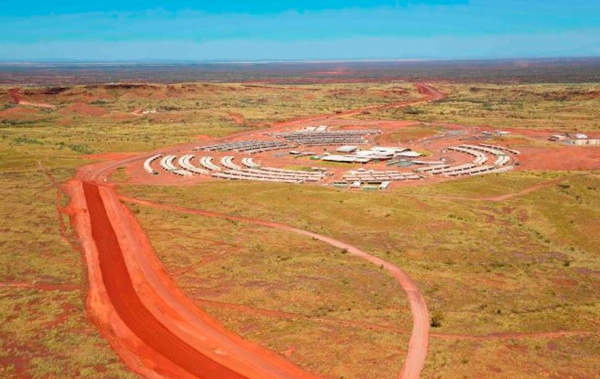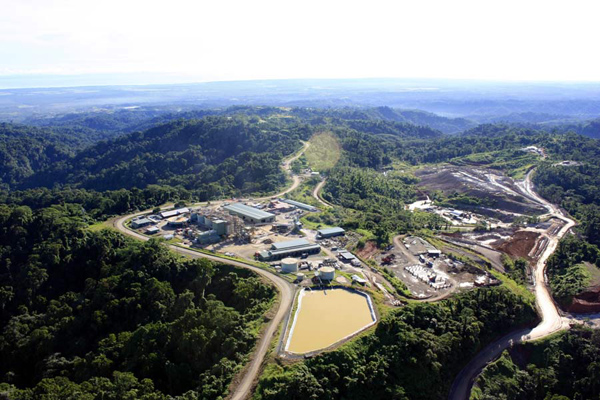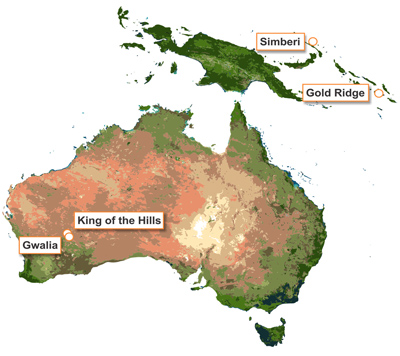Rinehart's Roy Hill starts owner-operator mining |
- Rinehart's Roy Hill starts owner-operator mining
- Gold ETF holdings drop again, hedge funds lose interest
- Gem Diamonds: no impact on Letseng from Lesotho crisis
- The wages-fuel-demand fallacy
- The case for a September gold price surge
- Burnt fingers in Guadalcanal gold mine battle
| Rinehart's Roy Hill starts owner-operator mining Posted: 01 Sep 2014 04:03 PM PDT  Image courtesy of Roy Hill. Aussie mining billionaire Gina Rinehart's massive Roy Hill iron ore project entered its next phase on Monday with the official start of owner/operator mining at the West Australian site. Rinehart, chairman of unlisted miner Hancock Prospecting, said Roy Hill "will employ thousands of Australians for decades and earn much needed export revenue for Australia. Roy Hill is currently the largest single mainland construction project in Australia." Roy Hill received $7.2 billion financing package from a consortium of lenders, the biggest ever provided for a mining project in the world according to Hancock, in March after 18 months of negotiations. Roy Hill will start shipping 55-million tonnes-a-year as early as September 2015 using a dedicated port and 344km railway and slot in behind Fortescue Metals Group as Australia fourth largest producer. Hancock holds 70% of the mine with equity partners Korea's POSCO, Japan's Marubeni and Taiwanese steel maker China Steel Corp, holding the remainder. The group has already spent over $3 billion on the project and the final bill is pegged at $10 billion. Roy Hill would add even more supply to a market expected to absorb some 170 million additional seaborne tonnes this year and next as the Big 3 iron ore miners continue to expand operations. Slowing demand in top consumer China and the extra tonnage has seen benchmark prices reach $87 a tonne, near five-year lows. That compares to over $130 a tonne when the project came off the drawing board. Rinehart is Australia's richest person with a fortune estimated at some $17 billion thanks to control of Hancock, which she inherited from her father who claimed swathes of the rich Pilbara iron ore deposits in the 1950s. |
| Gold ETF holdings drop again, hedge funds lose interest Posted: 01 Sep 2014 03:06 PM PDT Precious metals investors poured money into the sector during July, but safe haven buying dried up in August despite an escalation in geopolitical tensions. Global exchange traded funds backed by physical gold saw outflows last week of 6.5 tonnes, dropping total holdings to 1,726.4 tonnes, not far off four-year lows of 1,708 reached in June. 17 tonnes left during August and that compares to inflows in July which was the best since November 2012. Year to date 36 tonnes have left the dozens of funds traded around the globe and investment bank Barclays believes 100 tonnes could exit the market in 2014. Gold bullion holdings in global ETFs hit a record 2,632 tonnes or 93 million ounces in December 2012, but last year saw net redemptions of 800 tonnes. Silver is performing much better than the yellow metal with last week's addition of 45.3 tonnes in the holdings of silver-backed ETFs, bringing the total within shouting distance of October last year's record 20,121 tonnes. Like ETF investors, speculators in gold futures and options turned more bearish last week, but the most striking trend is the reduction in open interest – a measure of trading activity. Long positions – bets that the price will go up – held by large investors like hedge funds decreased to 129,611 lots in the week to August 26 according to Commodity Futures Trading Commission data released after the close of business on Friday. At the same time short positions, indicating weaker prices ahead, jumped sharply to 36,877 which translates on a net basis hedge funds holding 92,734 lots or 9.2 million ounces. Ole Hansen, chief commodity strategist at Denmark's Saxo Bank, sums up waning interest in gold trading this way: "During the past five months, gold has traded within an 8% range, but almost half the time the daily close has been within 1% of the average price during this time (1296 USD/oz). "Lack of movement, rather than than lack of commitment, is probably gold´s biggest headache for the time being as the yellow metal remains stuck between the potential negative impact of rising US interest against increased geopolitical uncertainties along with the risk of deflation in Europe." |
| Gem Diamonds: no impact on Letseng from Lesotho crisis Posted: 01 Sep 2014 02:10 PM PDT Gem Diamonds, owners of the Letseng mine in Lesotho, released a statement on Monday saying it did not anticipate any impact on operations from the political crisis in the tiny land-locked nation. Prime Minister Thomas Thabane fled Lesotho for South Africa on Saturday after the military in Lesotho disarmed police in the capital, Maseru, in what the prime minister called a military coup. Talks between the different factions mediated by South African President Jacob Zuma appeared to have some success with Lesotho's leaders agreeing to a roadmap with a "clear timeline" to re-open parliament. London-listed Gem Diamonds Limited said it "has seen media reports of army activity in Maseru, Lesotho but, at this stage, our management in Lesotho report that Maseru is calm and there is no disruption whatsoever at the company's Letseng mine which is situated some 4 hours from Maseru in the mountains." "It is not anticipated that there will be any impact upon operations at Letseng nor upon any of the company's sales and marketing operations in respect of the Letseng production," according to the company. Gem Diamonds owns 70% of the Letseng mine and the rest belongs to the Lesotho government. Since it took control in 2006 the mine the company has produced four of the top 20 largest white gem quality diamonds on record. Image: The Letšeng Legacy is currently ranked as the 16th largest rough white diamond ever recovered. Courtesy of Gem Diamonds |
| Posted: 01 Sep 2014 01:28 PM PDT An article by Alasdair Macleod, Head of Research, GoldMoney In recent months talking heads, disappointed with the lack of economic recovery, have turned their attention to wages. If only wages could grow, they say, there would be more demand for goods and services: without wage growth, economies will continue to stagnate. It amounts to a non-specific call to stimulate aggregate demand by continuing with or even accelerating the expansion of money supply. The thinking is the same as that behind Bernanke's monetary distribution by helicopter. Unfortunately for these wishful-thinkers the disciplines of the markets cannot be bypassed. If you give everyone more money without a balancing increase in the supply of goods, there is no surer way of stimulating price inflation, collapsing a currency's purchasing power and losing all control of interest rates. The underlying error is to fail to understand that economising individuals make things in order to be able to buy things. That is the order of events, earn it first and spend it second. No amount of monetary shenanigans can change this basic fact. Instead, expanding the quantity of money will always end up devaluing the wealth and earning-power of ordinary people, the same people that are being encouraged to spend, and destroying genuine economic activity in the process. This is the reason monetary stimulation never works, except for a short period if and when the public are fooled by the process. Businesses – owned and managed by ordinary people – are not fooled by it any more: they are buying in their equity instead of investing in new production because they know that investing in production doesn't earn a return. This is the logical response by businesses to the destruction of their customers' wealth through currency debasement. Let me sum up currency debasement with an aphorism: "You print some money to rob the wealth of ordinary people It is as ridiculous a circular proposition as perpetual motion, yet central banks never seem to question it. Monetary stimulus fails with every credit cycle when the destruction of wealth is exposed by rising prices. But in this credit cycle the deception was so obvious to the general public that it failed from the outset. The last five years have seen all beliefs in the manageability of aggregate demand comprehensively demolished by experience. The unfortunate result of this failure is that central bankers now see no alternative to maintaining things as they are, because the financial system has become horribly over-geared and probably wouldn't survive the rise in interest rates a genuine economic recovery entails anyway. Price inflation would almost certainly rise well above the 2% target forcing central banks to raise interest rates, throwing bonds and stocks into a severe bear market, and imperilling government finances. The financial system is simply too highly geared to survive a credit-driven recovery. Japan, which has accelerated monetary debasement of the yen at an unprecedented rate, finds itself in this trap. If anything, the pace of its economic deterioration is increasing. The explanation is simple and confirms the obvious: monetary debasement impoverishes ordinary people. Far from boosting the economy it is rapidly driving us into a global slump. The solution is not higher wages. |
| The case for a September gold price surge Posted: 01 Sep 2014 12:50 PM PDT July, August and September are typically gold's strongest performing months. But gold dropped 2.7% in July, and barely managed a gain in August. Gold futures inched higher on Monday as investors sought safe-haven assets amid increased tensions between Ukraine and Russia, after fighting intensified over the weekend. Gold for December delivery rose slightly to $1,288 on Monday and historically holding gold going into September reaps investors a more than 3% return. In this video Bloomberg's John Dawson explains that the September move up comes as buying from Asia – particularly due to upcoming festivals in India – increases. That pushes up premiums paid for gold. On the Shanghai Gold Exchange premiums improved to above $7 an ounce last week, but that's still a long way away from the $37 surcharge when gold was trading around $1,200 last year. While gold traders in India are now asking for $13 an ounce over the London price, premiums inside the country rose to a whopping $170 an ounce a year ago at the height of the country's gold import restrictions and ahead of the all-important festival and wedding season. Not everyone is convinced that this year the gold price will follow the same pattern in September. A recent note from investment bank analysts at UBS argues September 2014 may turn out to be a particularly weak period for the gold price: "Barring a move to $1200, physical demand from China is likely to remain quite subdued in the months ahead. This means that gold is lacking physical support from its biggest physical market, implying that the seasonality trade for September – gold's best performing month historically – is unlikely to follow its long-term trend." Image by Edson Walker |
| Burnt fingers in Guadalcanal gold mine battle Posted: 01 Sep 2014 11:56 AM PDT In August St Barbara evacuated all its staff from the mine after reporting a 'serious escalation' in security concerns, after the latest in a series of natural and man-made disasters at Gold Ridge this year. In April, operations at the mine which produced 46,000 ounces of gold in 2013, were halted following torrential rains that caused extensive damage and led to the evacuation of expat workers. St Barbara's staff were subsequently ordered by authorities not to return to the site. When that dispute was settled In June St Barbara found a large number of illegal miners had set up camp at the Gold Ridge open pit. More pain may loom: Standard & Poor's pegs their value at just 30 cents to 50 cents on the dollar in the event of default. The odds of that happening are rising after defaults by compatriot miners Mirabela Nickel Ltd. and Midwest Vanadium Pty. in the past year. Chief Executive Officer Bob Vassie told Bloomberg "There's a possibility, which is well advanced, of a win-win where the government can secure the future of the asset and we can leave with a clean exit with limited liabilities. That's what we are shooting for." The Gold Ridge mine commenced operations in 1998. After a period of being dormant, in 2010 a $150 million refurbishment and expansion project to around 100,000 ounces per year was started. St Barbara acquired the Gold Ridge mine in 2012 for over $500 million, according to the company website. Gold Ridge is situated approximately 40 km by road from the Solomon Island capital city Honiara. Honiara is approximately three hours flight from Brisbane, Australia. St Barbara last year produced 365,000 ounces of gold, with the bulk coming from its Gwalia mine in Western Australia. Image courtesy of St Barbara. |
| You are subscribed to email updates from MINING.com To stop receiving these emails, you may unsubscribe now. | Email delivery powered by Google |
| Google Inc., 20 West Kinzie, Chicago IL USA 60610 | |


0 Comment for "Rinehart's Roy Hill starts owner-operator mining"